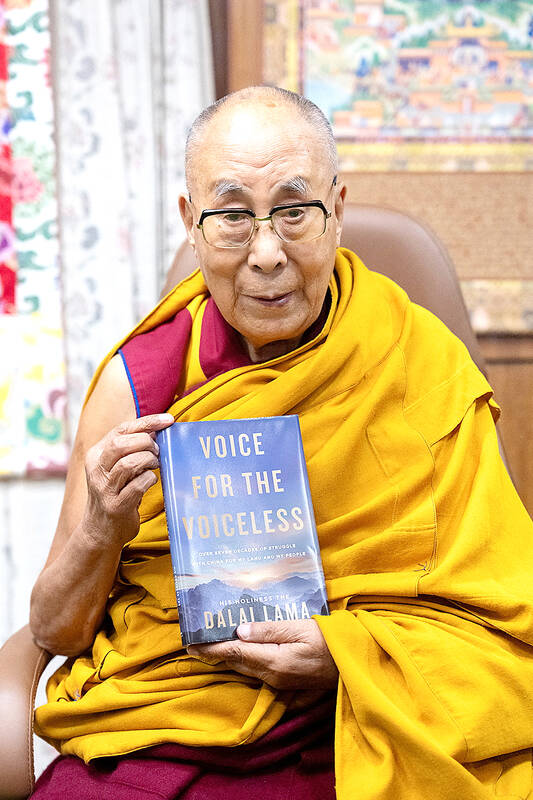The Dalai Lama’s successor would be born outside China, the spiritual leader of Tibetan Buddhism says in a new book, raising the stakes in a dispute with Beijing over control of the Himalayan region he fled more than six decades ago.
Tibetans worldwide want the institution of the Dalai Lama to continue after the 89-year-old’s death, he writes in Voice for the Voiceless, which was released yesterday.
He had previously said the line of spiritual leaders might end with him.

Photo: handout via Reuters
The book marks the first time the Dalai Lama has specified that his successor would be born in the “free world,” which he describes as outside China. He has previously said only that he could reincarnate outside Tibet, possibly in India where he lives in exile.
“Since the purpose of a reincarnation is to carry on the work of the predecessor, the new Dalai Lama will be born in the free world so that the traditional mission of the Dalai Lama — that is, to be the voice for universal compassion, the spiritual leader of Tibetan Buddhism, and the symbol of Tibet embodying the aspirations of the Tibetan people — will continue,” the Dalai Lama wrote.
Tenzin Gyatso, the 14th Dalai Lama, fled at the age of 23 to India with thousands of other Tibetans in 1959 after a failed uprising against the rule of the Chinese Communist Party.
Beijing insists it would choose a successor, but the Dalai Lama has said any successor named by China would not be respected.
China brands the Dalai Lama, who won the Nobel Peace Prize in 1989 for keeping alive the Tibetan cause, as a “separatist.”
When asked about the book at a news conference on Monday, a spokesperson for the Chinese Ministry of Foreign Affairs said that the Dalai Lama “is a political exile who is engaged in anti-China separatist activities under the cloak of religion.”
“On the Tibet issue, China’s position is consistent and clear. What the Dalai Lama says and does cannot change the objective fact of Tibet’s prosperity and development,” they said.
Beijing last month said that it hoped the Dalai Lama would “return to the right path” and that it was open to discussing his future if he met such conditions as recognizing that Tibet and Taiwan are inalienable parts of China, whose sole legal government is that of the People’s Republic of China. That proposal has been rejected by the Tibetan parliament-in-exile in India.
Supporters of the Dalai Lama and the Tibetan cause include Richard Gere, a follower of Tibetan Buddhism, and former US House of Representatives speaker Nancy Pelosi.
His followers have been worried about his health, especially after knee surgery last year. He told Reuters in December last year that he might live to be 110.
In his book, the Dalai Lama says he has received numerous petitions for more than a decade from a wide spectrum of Tibetans “uniformly asking me to ensure that the Dalai Lama lineage be continued.”
Tibetan tradition holds that the soul of a senior Buddhist monk is reincarnated in the body of a child on his death. The current Dalai Lama was identified as the reincarnation of his predecessor when he was two years old.

Former Nicaraguan president Violeta Chamorro, who brought peace to Nicaragua after years of war and was the first woman elected president in the Americas, died on Saturday at the age of 95, her family said. Chamorro, who ruled the poor Central American country from 1990 to 1997, “died in peace, surrounded by the affection and love of her children,” said a statement issued by her four children. As president, Chamorro ended a civil war that had raged for much of the 1980s as US-backed rebels known as the “Contras” fought the leftist Sandinista government. That conflict made Nicaragua one of

COMPETITION: The US and Russia make up about 90 percent of the world stockpile and are adding new versions, while China’s nuclear force is steadily rising, SIPRI said Most of the world’s nuclear-armed states continued to modernize their arsenals last year, setting the stage for a new nuclear arms race, the Stockholm International Peace Research Institute (SIPRI) said yesterday. Nuclear powers including the US and Russia — which account for about 90 percent of the world’s stockpile — had spent time last year “upgrading existing weapons and adding newer versions,” researchers said. Since the end of the Cold War, old warheads have generally been dismantled quicker than new ones have been deployed, resulting in a decrease in the overall number of warheads. However, SIPRI said that the trend was likely

NUCLEAR WARNING: Elites are carelessly fomenting fear and tensions between nuclear powers, perhaps because they have access to shelters, Tulsi Gabbard said After a trip to Hiroshima, US Director of National Intelligence Tulsi Gabbard on Tuesday warned that “warmongers” were pushing the world to the brink of nuclear war. Gabbard did not specify her concerns. Gabbard posted on social media a video of grisly footage from the world’s first nuclear attack and of her staring reflectively at the Hiroshima Peace Memorial. On Aug. 6, 1945, the US obliterated Hiroshima, killing 140,000 people in the explosion and by the end of the year from the uranium bomb’s effects. Three days later, a US plane dropped a plutonium bomb on Nagasaki, leaving abut 74,000 people dead by the

Indian Prime Minister Narendra Modi is to visit Canada next week, his first since relations plummeted after the assassination of a Canadian Sikh separatist in Vancouver, triggering diplomatic expulsions and hitting trade. Analysts hope it is a step toward repairing ties that soured in 2023, after then-Canadian prime minister Justin Trudeau pointed the finger at New Delhi’s involvement in murdering Hardeep Singh Nijjar, claims India furiously denied. An invitation extended by new Canadian Prime Minister Mark Carney to Modi to attend the G7 leaders summit in Canada offers a chance to “reset” relations, former Indian diplomat Harsh Vardhan Shringla said. “This is a